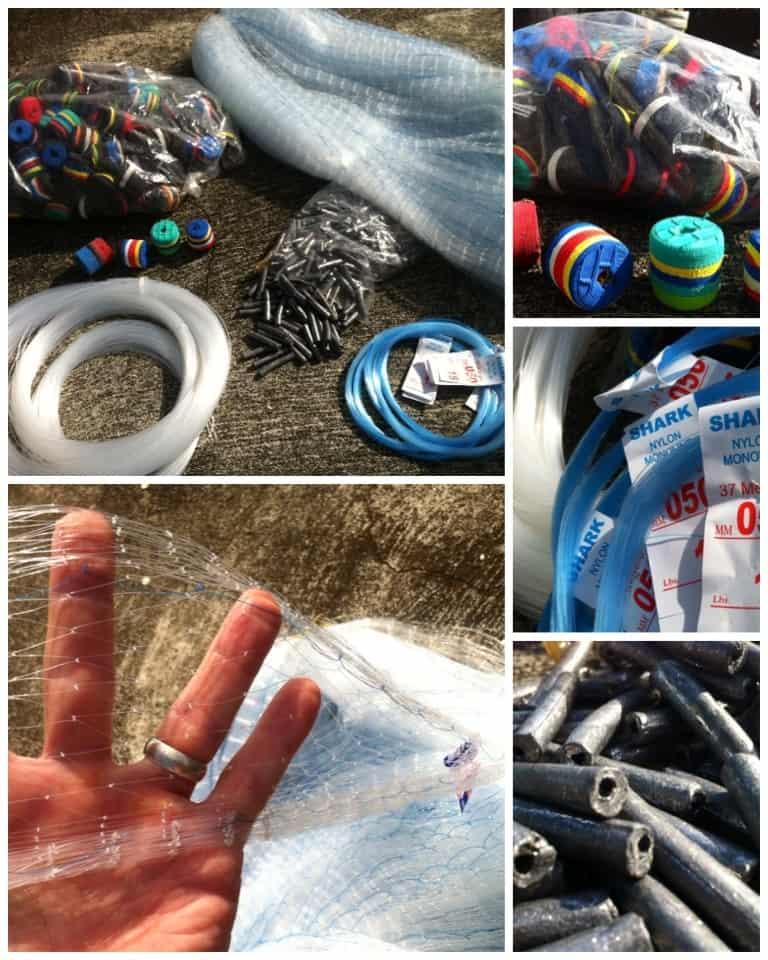Last Updated on October 25, 2024 by Ellen
If you give a man a fish?
If you teach him to fish?
What about a fishing net?
Similar results.
Hopefully, the nets we are preparing will help feed folks – and maybe provide a little income, if some excess can be caught.
The effort is part of our ongoing ‘fishing initiative’. Like our other self-help projects, it’s made possible in part by donations from our generous overseas contributors.
The program is directed at the impoverished, indigenous Ati tribe of the Philippines. The Ati are our neighbors and friends here in Malay, Aklan on the island of Panay, where we have paused our global vagabonding to wait out the coronavirus crisis.
Fishing nets part of larger initiative
We’ve already fixed up some paddle boats and helped with mechanical repairs to motorized watercraft. We’ve started distributing fishing tackle to individual Ati who fish regularly. Now we’re having nets made.
All of it is an attempt to help improve Ati lives now and in the future as they struggle at the bottom of a Philippine socioeconomic ladder made ever more unstable by COVID.
The other day I procured from our local fishing supply store the materials for the first batch of long, floating, weighted, fishing nets – called ‘lambat’ – that are common here in the Philippines.

The photos above show exactly what is required for a lambat net: 100 meters of monofilament netting (small weave for small fish) plus floats, lead weights, and additional fishing line to ‘sew’ the various pieces together.
In the end, a good lambat net hangs evenly from the water surface; one edge held on top by carefully attached floats, the other pulled/held down by similarly spaced weights. Passing fish are highly likely to be ensnared.
Lambat can be used/placed by either wading into chest-deep water or from a boat. The Ati will do both.
A lambat can be laid for an hour, many hours, overnight, or even days.

Fishing net assembly
Our lambat nets will be assembled by tall Tony pictured above. At 6’6″, Tony is the tallest Filipino I know, a friend, and a fishing net expert. Lambat do require careful construction.
In fact, sadly, I’m not sure the Ati have ever had the resources to put together proper lambat nets. Paying Tony a small salary to do so insures the nets will be made correctly – and helps spread some work/pesos around in our local community.
Tony gets 500 pesos ($10) for each 100-meter section. The materials per 100 meters cost about 2,000 pesos ($40) – slightly higher here in the Malay municipality than in the big provincial capital of Kalibo. Still, we are willing to pay a couple bucks more to help our local economy.
As I mentioned in an earlier blog post, the Earth Vagabonds are not big fans of fishing nets. Some environmental organizations decry them as ecological nightmares. I tend to agree in the case of larger, more commercial nets – which are often lost or abandoned.
But our particular lambat nets will undoubtedly be highly prized by the Ati who have requested them. There is little chance of them becoming ocean-polluting ‘ghost nets’.

Weather wild card
The only real issue we currently have is the fishing conditions. As seen in the photos above, people (including many females) constantly fish along our shoreline. But the seas are unsettled at this time of year. The season, known as ‘Amihan’, brings gusty northeast winds, waves, and currents to our northeast facing seashore.
Such conditions do not favor lambat net fishing. But the situation is temporary – so no reason not to prepare the nets as tall Tony is doing. In the coming weeks, we hope to have eight to 10 lambat ready for Ati use when the waters calm again.
In the meantime, we continue distributing line fishing equipment (lines, hooks, sinkers) to any Ati who wish to attempt a catch. (Rods & reels are rare and expensive in the Philippines). The hand tackle can more easily be put to use regardless of the weather. Each individual rig of 25 meters of line, 10 hooks, and a few sinkers costs about $1.
Fingers crossed for many fish!
Finally, the other variable with fishing is the fish! And honestly, so much fishing has been done here in Malay since the economic collapse caused by COVID that fish stocks are way down. Nets are sometimes empty!
Still, people gotta eat – and the Ati will keep trying. Hopefully, the Amihan currents might bring some fresh fish schools and the gradual restart of the local tourist economy will mean less fishing competition.
As always, be thankful and generous, happy trails & more beer.
Life is NOW!
Thanks for reading, “Fishing nets for our Ati friends.”
Visit our special page with every post about the Ati tribe.

